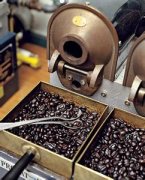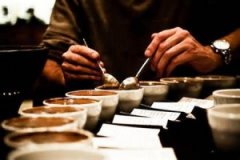Coffee roasting degree explanation
1. When studying the roasting degree of coffee beans, the degree of roasting can be judged by sound, color and aroma.
Its color from light gray to dark brown, aroma from elegant gradually rich; sound is issued twice burst sound, take high temperature resistant raw beans as an example, about 7 minutes from the first explosion, lasting about 2 minutes, its sound is low, indicating the beginning of pyrolysis, starch into caramel, water evaporation, exhaust, about 12 minutes issued a second explosion, sound sharp, indicating cell fiber fracture, baking deeper.

Second, the famous American Fine Coffee Association (SCAA) promotes the caramelization analysis value (Agtron number) determined by the red line to determine the degree of roasting, and its value ranges from 0 to 100. The higher the value, the lower the caramelization, the gray color, and the lighter the roasting. Conversely, the lower the value, the higher the caramelization.
Third, the well-known coffee roasting degree is the American term light roasting, medium roasting, deep (heavy) roasting, which can be subdivided into 8 stages, and the difference in roasting degree has different views with different regions. The following briefly introduces the roasting degree and flavor:
(1)Light Roast: Very light roast, also known as "light roast"
Time of next bean: before and after the first explosion
Flavor: The bean table is light cinnamon color, with a strong grassy flavor, taste and aroma is insufficient, generally used for testing, rarely used for tasting.
(2)Cinnamon Roast: light roast, also known as cinnamon roast
Time for beans: from the beginning of a burst to dense
Flavor: Cinnamon color on the surface of the beans, the grassy flavor has been removed at this time, strong acid, slightly aromatic, often used to brew American coffee.
(3)Medium Roast: Medium Roast, also known as "Slightly Roast"
Time of next bean: from one explosion to the end
Flavor: Chestnut color on the surface, light taste, sour with bitterness, moderate aroma, retaining the original flavor of coffee beans, often used as American coffee or mixed coffee.
(4)High Roast: medium, slightly dark roast, also known as "thick roast"
Next Bean Time: End of First Burst
Flavor: Bean surface is light reddish brown, taste fresh and rich, sour and bitter balance is not stimulating, and slightly sweet, aroma and flavor are good, Blue Mountain, Gili Mazaro coffee are suitable for this degree of roasting, for Japan, Central and Northern Europe people love.
(5)City Roast: Medium Deep Roast, also known as City Roast
Next bean time: after the first explosion, that is, the middle of the first and second explosions
Flavor: light brown beans surface, taste bright and lively, acid bitter balance between the acid and light, and the release of high-quality coffee flavor, for the standard degree of roasting, but also the public's favorite degree of roasting, Brazil, Colombia coffee are suitable for this degree of roasting, often used in French coffee.
(6)Full City Roast: Deep Roast, also known as Deep City Roast
Next Bean Time: Second Burst
Flavor: The beans are brown in color, stable and full in taste, bitter and sour in taste, sweet in aftertaste, full in aroma, Central and South American roasting method, mostly used for iced coffee and black coffee.
(7)French Roast: Very deep roast, also known as French roast.
Time of next bean: from the second explosion density to the end of the second explosion
Flavor: dark brown with black bean surface, strong taste, bitter, light acidity almost senseless, with rich chocolate and smoke aroma, for Europe by France is the most popular, more coffee Oulei, Vienna coffee with.
(8)Italian Roast: very deep roast, also known as Italian Roast
Time for beans: from the end of the second explosion to the black oil on the bean surface
Flavor: Black and oily, coffee bean fiber before carbonization, strong taste complex, bitter, with a strong roasted and burnt aroma, mainly popular in Latin countries and Italy, more Italian coffee Espresso use.
From the perspective of roasting degree, the deeper the roasting degree, the stronger the bitterness; the lighter the roasting degree, the stronger the sourness. The degree of roasting depends on the characteristics of the coffee beans themselves. For coffee beans with strong bitterness and light acidity, moderate and light roasting degree is generally selected.
Important Notice :
前街咖啡 FrontStreet Coffee has moved to new addredd:
FrontStreet Coffee Address: 315,Donghua East Road,GuangZhou
Tel:020 38364473
- Prev

Introduction of coffee utensils roaster
The roaster is mainly divided into four types: direct fire type, semi-hot air direct fire type, hot air type and electric type. 1. Direct fire is the earliest baking tool, that is, the raw beans are roasted by fire and then transferred to the drum. The built-in motor keeps running the drum and stirring the coffee beans in the drum, trying to make each coffee bean come into contact with the hot iron evenly to achieve the goal of balanced roasting.
- Next

What is a cup test?
Coffee cup testing is not only a professional skill, a profession, but also a pleasure, so we can do it at work, in class, in formal activities, at home, on leisurely occasions, or communicate with friends. During the cup test, the cup tester should smell the dry aroma of the coffee, use the cup spoon to break the residue, release the wet fragrance of the coffee in the cup, suck the coffee liquid, and make the coffee fog throughout.
Related
- Beginners will see the "Coffee pull flower" guide!
- What is the difference between ice blog purified milk and ordinary milk coffee?
- Why is the Philippines the largest producer of crops in Liberia?
- For coffee extraction, should the fine powder be retained?
- How does extracted espresso fill pressed powder? How much strength does it take to press the powder?
- How to make jasmine cold extract coffee? Is the jasmine + latte good?
- Will this little toy really make the coffee taste better? How does Lily Drip affect coffee extraction?
- Will the action of slapping the filter cup also affect coffee extraction?
- What's the difference between powder-to-water ratio and powder-to-liquid ratio?
- What is the Ethiopian local species? What does it have to do with Heirloom native species?

